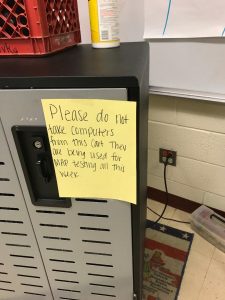Voices are already rising, speaking up to warn us that virtual learning will widen the U.S. achievement gap. In a fractured year, beset by learning losses, the risks from online instruction must not be slighted. Our property-tax-based funding system has long ensured that wealthier students have more access to academic resources than less lucky counterparts. When those differences were merely battered versus new textbooks, and occasional shortages of markers or #2 pencils, funding differences could be (mostly) ignored. Teachers in poor schools simply spent much more of their own money on markers and pencils, among many other supplies. But students everywhere (mostly) had the tools for learning.
Online-learning is a game changer though. We can’t let COVID-19 distract us from the technology gap. As distance learning becomes the norm in some areas, we must put our gaps — both technology and achievement — into the spotlight.

Remote learning won’t be easy. The technological piece has been a hidden flaw in our property-tax-based funding system ever since the first school computer labs arrived. Socioeconomically advantaged areas are heading into 2020 with ridiculously more ammunition in their learning arsenals. After I retired, I subbed in wealthy and economically-disadvantaged areas — working where I lived and where I had once taught. Technological ironies did not escape me. In neighborhoods where each child already has an iPad or MacBook at home, schools issued 1:1 devices to take home. In areas where the only internet connection may be on phones, schools passed out devices from computer carts and then collected them at the end of the school day.
Schools are working frantically to get those devices into homes now in areas where education has left the building. But all those years of growing up with technology in the home still leave groups of students at a technological advantage. Even typing speed matters. Students who have been keyboarding since youth can get a great deal more work done sometimes simply because, in a fixed amount of time, 60 words per minute produces a great deal more output than 20 words per minute.
We must shine the spotlight on the achievement gap this year — as often as possible. The fight to keep COVID from widening that gap will be a real one — and let’s hope for funding help sooner rather than later. No child should have to go online on a phone in a parking lot to find out that day’s assignments.
Many children with no internet connection at home have been doing their homework in fast food restaurants and coffee shops. In too much of the country, though, that option is no longer available right now. Restaurants are closed or family members don’t want children sitting for hours in public locations. Those students may in fact be working in parking lots.
Eduhonesty: I view this as a COVID-19 opportunity. In parts of the country, school is appropriately being offered online. Let’s get the information out there now: Does your school have adequate technology for 1:1 learning, the tech power to send home a functional device so every student can access the internet? Do students have internet connections? How many students are out of luck because their Chromebook or device is broken? Or because something has gone wrong with a charger? How much technical support is available to students?
Due to differences in school funding, the tech gap has been taken as a given, a strange version of “we will always have the poor among us.” But that technology gap will factor hugely in the achievement gap over the next year or two. “Maria” in the house with computers in her mom’s office, her dad’s office and her own bedroom can pretty much ignore technology. Some desktop, laptop, or iPad will deliver the information her teacher provided in her virtual classroom. But what about “Ramon,” who has been relying on mom’s phone and who now needs to figure out this new hunk of metal that he has been issued? How will we keep Ramon in the game?
My suggestion to teachers and others: Share. When you see your students or your child at a disadvantage technologically, when you see the tech gap interfering with learning, go online. Share that missing internet connection. Write what you see on Facebook or other platforms. Tweet what you see. Find me at
#eduhonesty@ShastathePlaid
and I will be happy to share for you. The technology gap has been pervasive, long-standing, misunderstood and underreported. Let’s seize this time to try to fix that gap.
————————————————————————————————————————-
The right direction: https://oklahoman.com/article/5669779/covid-relief-funding-helping-okc-schools-fill-technology-gap
“While more affluent districts implemented 1:1 technology long ago, low income urban districts have faced many challenges in making it happen. Funding issues and connectivity voids for families have been major hurdles to overcome, both of which have been tackled by Oklahoma City Public Schools in the time since schools closed last spring. Utilizing federal and state CARES Act funding has allowed OKCPS to purchase devices for all students, and WiFi hot spots for families without connectivity.”
A quick numerical snapshot of the problem: https://truthout.org/articles/technology-access-gap-leaves-millions-of-students-struggling-to-keep-up/
“A 2017 survey of more than 400,000 K-12 students, teachers, librarians and school administrators conducted by Project Tomorrow, a California nonprofit dedicated to educational equity, found that lack of in-home internet access is an enormous problem for students in all 50 states. This has been corroborated by researchers at Pew Research who discovered that 17.5 percent of school children in grades 6 to 12 have ongoing difficulties completing school work due to a lack of internet access.”
https://www.cps.edu/strategic-initiatives/chicago-connected/eligibility/ Credit to Chicago which is working to make sure all its students are connected.
